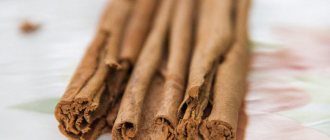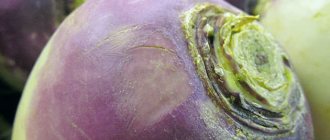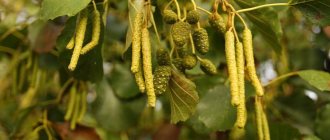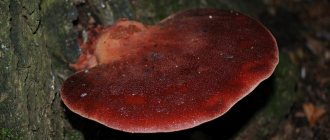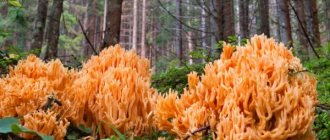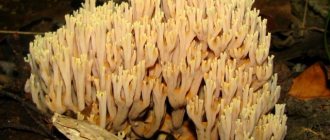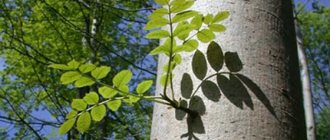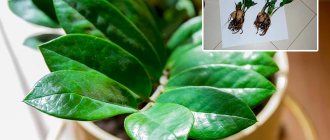Types and varieties of plants, appearance
Aconite is a perennial meadow grass of the buttercup family. This herbaceous plant has large heart-shaped leaves and an erect, tall stem with small branches at the top and a ribbed base. The aconite flower consists of eight petals and forms bluish-violet or gray-yellow inflorescences at the edges of the stem. Despite the fact that this perennial is considered a poisonous plant, due to its beautiful large inflorescences it is often used for decorative purposes.
One of the most common types of aconite is Aconitum napellus. It is also popularly called “blue buttercup”, “wolf root”, “lumbago grass”, “skullcap” and “goat death”. Quite often you can find another variety of it, namely the Cristiana Rubellum. Its inflorescences are colored not blue, but soft pink. Curly wrestler is also used as a decorative decoration.
Poisonous properties of aconite
Humanity learned to use aconite toxins a long time ago: they smeared arrowheads with them and poisoned food and water that were intended for the enemy or large predators. They say that the glorious Timur also died, poisoned by a skullcap soaked in aconite poison. Not only the organs and juice of the plant are poisonous, but even its smell: Roman soldiers lost consciousness from it and suffered from bilious vomiting.
The reason for the toxicity of the wrestler is the alkaloids it contains, which cause paralysis of the respiratory center in living beings, accompanied by convulsions.
- Yaskolka: growing and care in the garden
The warmer the climate in which aconite grows, the more poisonous the plant is, but in cool conditions the aconite can completely lose its dangerous properties. For example, in Scandinavian countries, aconite grass is fed to livestock. And in the middle zone, cultivated aconite in fertile soil becomes completely harmless after a few seasons.
In the photo: Blooming aconite
Where and how does it grow
Aconitum is common in North America, Europe and Asia. It is most often found in damp places, on roadsides and in mountain meadows. In total, there are about 330 species of aconite, of which about 75 can be found in the wild on our territory.
Fischer's aconite is found in the Far East. The Flerov wrestler is listed in the Red Book and can only be found in the Vladimir region. In Kyrgyzstan, China, Kashmir and Kazakhstan, the Dzungarian wrestler is common. In central China, Carmichel's Fighter can be found in the wild. In the south of Western Siberia, the white-mouthed wrestler grows. It is also found in Mongolia and Central Asia.
Culture propagation
Aconite can be propagated in several ways:
- Cuttings. This is the fastest way to reproduce. In the spring, while the young shoots have not yet become hollow inside, they are cut off and immersed in the soil. Cover the top with film, forming a greenhouse.
- Rhizome division. Also an easy way. In spring, the side part of the rhizome is separated and planted separately.
- Seeds. They are sown in the fall, immediately after harvest. The next year, their germination rate drops by 50%. Seeds are sown in moist soil and await germination in the spring.
Application
In medicine
In folk medicine, aconite is often used to treat the following diseases:
- arthritis;
- osteochondrosis;
- migraines and headaches;
- epilepsy;
- paralysis;
- depression;
- gout, etc.
Medicines based on root tubers are used for radiculitis, neuralgia and rheumatism. The use of this plant in medicine is limited by its extreme toxicity.
At home
Aconite tincture can be used as a powerful insecticide to get rid of flies and cockroaches. Sometimes the dried root, crushed into powder, is used for this.
In cosmetology
Due to its anti-inflammatory and antimicrobial properties, aconite is sometimes used to combat skin diseases. It is necessary to use aconite tinctures and creams very carefully, since in some cases, the substances included in their composition can provoke an exacerbation of the disease and aggravate the skin condition.
Description of a poisonous plant
Aconite grows in the forest and in summer cottages. If you look closely at its flowers, they will resemble the cultivated delphinium, and these plants are indeed related.
All parts of aconite are poisonous, especially during flowering. You should not touch flowers with your hands or try to pick them; even their smell can cause a headache.
There is a statement that cultivated varieties contain fewer toxins, especially if they are repeatedly cultivated in one place. But when replanting a plant and caring for it, it is advisable to follow safety precautions and wear rubber gloves.
- In the hooded aconite, a new tuber-shaped root grows every year, and the old one dies.
- There are plant species with slightly twisted tap roots or perennial tubers.
- The leaves are round, alternately arranged, and consist of 5 or 7 lobes.
- The flowers grow at the top of the stem, which reaches 0.5 - 1.5 m in height.
- The color of the corolla is most often blue, but yellow, blue, lilac, and white are also found.
Nutritional value and chemical composition
Aconite contains a fairly large number of alkaloids, acids, resins, micro- and macroelements. It is because of this specific composition that the wrestler is very poisonous. In the leaves and roots you can easily find alkaloids of the first group, but aconitine predominates here in percentage terms. Among the alkaloids of the second group, sparteine, napalline, and ephedrine can be distinguished.
The beneficial properties of aconite are largely due to the presence of a fairly large amount of acids in it, in particular, linoleic, oleic, myristic, palmitic, fumaric, citric, steoric, etc. In addition, aconite contains potassium, iron, manganese, nickel, calcium, barium , magnesium, copper, chromium, zinc, etc.
Use in landscape design
Aconite bushes look impressive in areas both alone and in groups. Also, when designing flower beds, they are often combined with other flowers, for example, phlox, yarrow and daylilies.
Due to the height of the plants, landscape designers use them as a backdrop for other flowers. Climbing representatives of aconites are planted near hedges and arbors. Their vines weave around fences, thereby creating hedges.
You can experiment with color, because aconites have quite bright colors. For example, blue varieties will go well with yellow or red flowers.
When growing aconites, we must not forget about our safety, although garden plants are not too poisonous, but when working with them, it is better to play it safe and wear rubber gloves.
How to grow, care and pests and diseases
Aconite is a low-maintenance herb. But you need to take into account that aconite does not like stagnant water. Despite the fact that these herbaceous plants grow quite well in sunny places and in the shade, direct sunlight can harm them and simply burn them.
Planting aconite requires certain preparation: the seeds must be kept at a temperature of 20 degrees for a month, and then kept in the cold for another month. This will harden the seeds so they will germinate more evenly. Seeds prepared in this way are suitable for open ground. For high-quality growth of aconite, air permeability, timely hydration and nutrition, as well as drainage are also important.
Despite the fact that aconite is a poisonous plant, its leaves are often inhabited by flower beetles, spider mites, aphids, leaf slugs and root-knot nematodes. Bioinsecticides, such as fitoverm, intavir, lepidocide, etc., have proven their effectiveness in pest control. In addition, wolfsbane is susceptible to viral and bacterial diseases.
Flowers are often infected by a virus that causes the inflorescences to turn green, and the plant itself may suffer from powdery mildew. Viral diseases, unfortunately, cannot be cured, but fungal diseases can be effectively combated with the help of biological products such as phytosporin, gamair and alirin.
Growing aconite
If you decide to grow aconite, planting and caring for it in open ground will not require much effort. This is an unpretentious plant. Many species winter well.
Light-loving species are Antorra aconite (Aconitum anthora) and Carmichael aconite (Aconitum carmichaelii). It is better to plant them in elevated areas. Other species tolerate excess humidity.
The plant tolerates transplantation well. It is better to divide the bushes in the spring, but you can also divide them in the fall. There should be no stems. Make the planting hole wide and deep so that the rhizome is comfortable. Before planting the plant, you need to pour mineral fertilizer (15-20 g) into the hole. The depth of the root neck is 1-2 cm. The distance between the bushes is 25-30 cm.
Propagates well vegetatively, by dividing bushes. Worse - seeds. Seed propagation does not preserve the characteristics of the variety. Before sowing, it is better to perform stratification. Flowering should only be expected for 2-3 years.
Care
Care is as follows:
- You need to loosen the soil regularly.
- feeding once every 1-2 months.
- dried inflorescences must be removed.
- if the season is dry, the plant is watered.
The plant is prone to powdery mildew.
Preparation and storage
Since the fighter plant is quite poisonous, all manipulations aimed at collection and subsequent storage should be performed only with gloves, since aconite poisons can very easily penetrate the pores of the skin.
Almost all parts of the plant are used to prepare medicines. The roots are harvested from August to October. To do this, they are dug up and washed thoroughly, separating the adhering soil. The roots should be dried at temperatures up to 70 °C in a well-ventilated area. They need to be stored in a dry, dark place.
The leaves are collected before flowering begins, that is, from June to July. Only intact leaves and inflorescences should be selected. Next they are dried in the shade. Dried leaves should be stored in a glass container out of the reach of children and out of direct sunlight.
Having completed all the necessary preparations, you must wash your hands thoroughly with soap.
Description of aconite
The plant contains poison in the leaves, stem, root and seeds. It is easy to become poisoned by the aroma of the flower if you inhale a large amount of pollen. The herbaceous perennial plant belongs to the Buttercup family. Aconite has an erect stem that is light green in color. In nature, it grows as a lush bush more than 30 cm high or as a vine stretching up to 3 m.
Aconite hooded Album
The rhizome of aconite is developed; in a young plant it grows up to 15 branches at once. The ability to well absorb nutrients from the soil affects rapid growth. The rhizome reliably covers a large area of soil, due to which the erect bush is stable and does not fall from the wind.
Important! Popularly there are many other names, for example, wolf root or dog death. According to legend, arrowheads were treated with poisonous aconite juice before hunting large predators.
Dense shoots with foliage grow from the rhizome of aconite. It is large in shape, finger-shaped with a dissection, and has good decorative properties. The foliage is arranged alternately on the stem. The diameter of the leaf plate reaches 15 cm, on the front side it is dark green in color, and the back part has a grayish tint.
Aconite has large inflorescences, but their shape is not typical for buttercups. The flower resembles the helmet of an ancient warrior with a crest. It is formed by modified sepals. A distinctive feature is the absence of spurs. The flowers are collected in a large brush formed at the top of the shoot. The color is most often blue or purple, but there are plants with white and yellow inflorescences.
In place of the flower, a seed capsule ripens in the fall. The grains are small and ripen in October, which is easily identified by the black or brown color of the shell.
By the onset of cold weather, the above-ground part dies off. The root overwinters well in the ground and grows new shoots the next season.
The young plant is considered the most poisonous. As it matures, the poison is removed from the foliage and stems. A tiny amount of the harmful substance remains, which cannot cause serious poisoning.
Important! Aconite, which grows in warm regions, accumulates the most poison.
Geography of growth
The plant is widespread in the European central part and has become a favorite in northern Asia. Some species are found in America. The flower loves space and fertile soil, grows near rivers and reservoirs, and populates meadows and mountain valleys.
Flower growers grow aconite in flower beds. The crop grows quickly; if you neglect to care for it, the plant runs wild. Blooming aconite candles are found along country roads, in abandoned areas.
Wrestler: description
Aconite is a relative of larkspur and spur, but its zygomorphic flowers differ from the classic ranunculaceae flowers and are more similar to the candles of the legume plant lupine. The irregular blue, cream, yellow, purple or white flowers of the borer usually form a pyramidal head or large raceme, sometimes reaching half a meter in length.
The root system of the wrestler is rhizomatous or root-tuberous. Its roots penetrate to a depth of 5-10 to 30 cm. Shoots of aconite are usually straight, ranging from 40 to 160 cm in height, but in climbing representatives they can grow up to four meters or more. Palmately divided, lobed or dissected dark green leaves are arranged alternately on the stems. The fruits of the wrestler are leaflets with small seeds that do not lose germination for up to one and a half years.
Bees take aconite nectar in exceptional cases, only if there are no other honey plants nearby: the poison of this plant is also dangerous for insects.
Description and varieties
North America, Asia, and Europe are home to 300 species of aconite.
And only some varieties can be planted in the garden, as the plant is considered poisonous. Let's look at a few of them. Aconite:
- Klobuchkovy . The buds have the shape of a tavrik. It is a low-growing variety, reaches a height of 60 cm, the color of the buds is violet-blue or blue.
- The capillary is pyramidal in shape. The bush can be 1.5 meters tall, has large inflorescences and has a rich violet-blue or aqua color.
- Baikalsky . The helmet is hemispherical in shape. Reaches 1.2 meters in height with a straight stem. The buds are dark purple - 1.5 cm long. Pleases with flowering from July to October. Homeland Eastern Siberia.
- Curly . The inflorescences are rounded-conical in shape. Height is 0.45–1.15 m, and some varieties can reach four meters. A twining stem with thin pentagonal leaves. The flowers are dark blue and quite large, up to 3 cm.
- Motley . The shape of the helmet is highly bell-shaped, with dense leaves and blue in color. The stems reach 1.5 meters long.
- Northern . The flowers are ovoid-round in shape. The stems reach 2 meters in height.
Northern
Motley
Curly
Baikal
Pyramid-shaped capillary
Klobuchkovy

